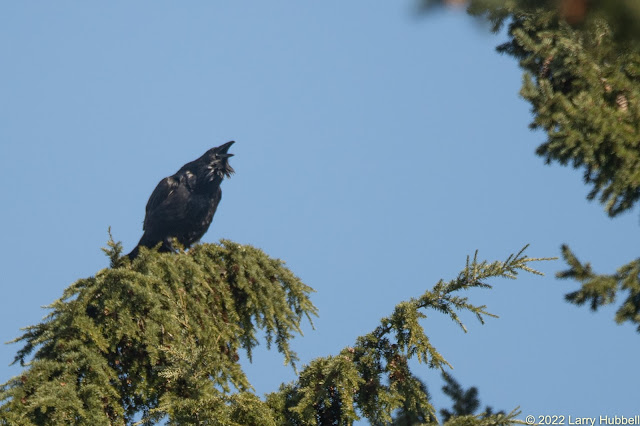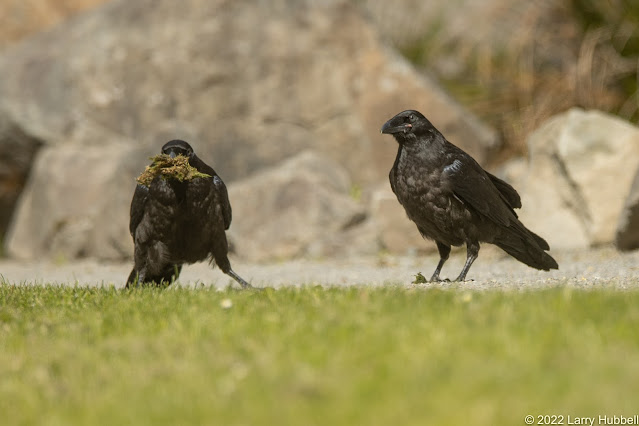The obvious hackles, the exceptionally long feathers sticking out from the throat, are only noticeable on Ravens. Also, Common Ravens can have a wingspan of nearly four feet rather than three. Ravens can weigh over three pounds instead of being closer to one. I have never noticed a Raven flicking its tail like a Crow. Also, their voices are dramatically different. Although, I have no doubt that a Raven could imitate the calls of a Crow if it was so inclined.
In-flight, Ravens tend to flap their wings less. They often glide from one tree to the next. When they need to gain elevation, like when taking food up to the nest, they often circle upwards on thermals. While soaring up with their long wings extended, they appear much calmer than constantly flapping Crows.
Towards the end of April, an adult flew into the new nest tree and landed somewhat below the nest. It hopped and leaped up through the branches to deliver food to the excited young birds.
The three young were still branching - standing on branches near the nest and flapping their wings. Soon after, they gained the confidence and strength to leave the nest. Here you can see the partially complete flight feathers.
People often ask how I found the nest. The simple answer is I saw the Raven delivering this branch to the tree.
However, that was just the final step in a longer process. Earlier in the year, I noticed one of the adults, presumably the male - assuming the female was on eggs, while he was sitting on various treetops. Occasionally, he would leap into the air and loudly chase after predators, like Bald Eagles. The area he appeared to be defending was a bit further south than what he defended the previous two years. Plus, in 2020, I watched one of them take a few branches to a tree near this year's nest site. Even though they did not use the new site at that time. These hints helped guide my attention.
Last week, as I was passing a Big Leaf Maple tree southwest of the new nest, I heard the call of a Red-tailed Hawk. It sounded very close. It was as if the Hawk was sitting on a branch just above my head. When I turned to look, I was face to face with one of the young Ravens. I never heard the Hawk sound again.
I do not know if the call was meant as a warning, to indicate to its siblings that I was a creature to be feared, or if it was an attempt to scare me away. In any case, I soon noticed that all three of the young Ravens were hanging out in the grove of Big Leaf Maples.
They were waiting calmly and were not disturbed by my presence. While sitting on horizontal branches, they often closed their eyes while waiting for their parents to bring them food. Occasionally, they would wake up and preen or wander along a branch while investigating their surroundings.
In this photo, the young one was inspecting a mossy piece of bark.
Ravens are omnivores. They are happy to eat meat, like rats, squirrels, young rabbits, or nestling crows - that the parents raid from nearby nests. But they will also eat a wide variety of vegetation. Previously, I have seen an adult eating fresh blossoms off a Big Leaf Maple and watched their offspring eating small fruits from various trees in the Arboretum collection. The second video, in last year's post shows the five young plucking fruit from a tree southwest of the Don Graham Visitor's Center.
Note: The first video in last year's post provides a chance to hear the begging cries of young Ravens. This is a great time to become familiar with these sounds especially if you plan on being in the Arboretum during the next month or so.
I did not see this one find or consume any food from the moss. Its behavior seemed more like a bored child or dog that was teething.
How it easily held the bark, while gnawing on it, looked surprisingly adept.
Ultimately, it simply dropped the mossy bark.
The flesh-colored gape, at the corner of the mouth, is an indication of youth, as are the light-colored irises. I also suspect the fluffy feathers, sticking out like pantaloons, are just part of the process of molting into adult feathers.
When an adult returned to the area with food, the three young flew out of the Maples and landed near the adult. The aggressive begging for food looked quite intimidating.
Amazingly, the two young on the right, seem every bit as large as the adult on the left. By using the nesting facts from All About Birds we can estimate the age of the young Ravens.
If the nestling period averages around 20 days and the incubation period averages 17 and the young left the nest around May 1st, then the eggs were probably laid around March 24th. This would make the young, as of today, just a little over a month old. Clearly, there is play in these assumptions. However, even if they are actually 6 weeks old their development is still stunning.
This angle shows the bright pink flesh on the inside of the young bird's mouth. You can compare this to the totally black inner mouth of the airborne adult in the third photo in this post.
From this angle, the difference between the gape of the young bird and that of the adult is more subtle. Even though the young one was loudly begging it was not attempting to take the food from the adult. The adult appeared to calmly analyze and decide which of the offspring will get the food.
Even though the adult dropped the food for a moment, (in the very first photo) the young waited for the adult to actually place the food inside its mouth. it did not grab for the food in the way I would expect to see a young Bald Eagle behave. I wonder if this is a difference between songbirds and raptors. Ravens are the world's largest songbirds.
From this angle, their light-colored irises are a bit more obvious.
The bird on the left had the better grasp and really put its weight into the effort.
Not surprisingly, the moss separated into unevenly divided portions.
The sibling on the right is unimpressed with the portion it secured and remains focused on the larger prize.
The lefthand sibling clearly won the match.
However, with nothing left to prove the bird drops the moss...
... and turns away.
One last thought. A few weeks ago, while taking photos of an adult who was sitting on top of a tree in bright sunlight, the Raven looked down at me. It flew closer and landed directly behind me on a second tree. Being totally black, even though it was still on the outer portion of the tree, it was hidden from me in the shadows. On the other hand, I was now one looking into the sun. It seemed to me that the Raven intentionally moved into the shade so it could safely see me without being seen.
The mystery of their intelligence is very intriguing. Perceptions and feelings do not constitute scientific proof. The example above could have just been a coincidence. I hope someday scientists can devise elegant and harmless ways to research and prove the intelligence of Ravens.
Have a great day on Union Bay...where nature lives in the city!
Larry
Going Native:
Each of us, who breathe the air and drink the local water, needs to watch and protect our local environment. Native plants and trees encourage the largest diversity of lifeforms because of their long intertwined history with our local environment and native creatures. Even the microbes in the soil are native to each local landscape.
I hope we can inspire ourselves, our neighbors, and local businesses to respect native flora and to support native wildlife at every opportunity. I have learned that our most logical approach to native trees and plants (in order of priority) should be to:
1) Learn and leave established native flora undisturbed.2) Remove invasive species and then wait to see if native plants begin to grow without assistance. (When native plants start on their own, then these plants or trees are likely the most appropriate flora for the habitat.)3) Scatter seeds from nearby native plants in a similar habitat.4) If you feel you must add a new plant then select a native plant while considering how the plant fits with the specific habitat and understanding the plant's logical place in the normal succession of native plants.
***************
My friend Elaine Chuang shared several resources (that were new to me) from the January 2022 Washington Ornithological Society meeting. The major new concept is that specific keystone native plants enable critical moths and caterpillars that in turn provide food for the great majority of birds, especially during the breeding season. Here are the top two links from her list.
Native Keystone Plants for Wildlife:
https://www.youtube.com/watch?v=O5cXccWx030
Resources for adding plants to your Pacific Northwest Garden:
https://wos.org/wos-wp/wp-content/uploads/2021/12/native-plant-resources-v2.pdf
***************
In the area below it is my intention to display at least one photo each week to help challenge us to know the difference between native and non-native lifeforms.
Scroll down for the answer.
******************
They are:
Orange Honeysuckle - Also called Western Trumpet Honeysuckle and
Indian Plum - Also called Osoberry
Indian Plum is already starting to bear fruit, although the plums are not yet ripe.
*****************
The Email Challenge:
In response, I have set up my own email list. With each post, I will manually send out an announcement. If you would like to be added to my personal email list please send me an email requesting to be added. Something like:
Larry, I want to see more of nature. Please add me to your personal email list.
Thank you for your patience and interest!
Another common issue is losing your input while attempting to leave a comment on this blog. Often everything functions fine, however, sometimes people are unable to make it past the robot-detection challenge or maybe it is the lack of a Google account. I am uncertain about the precise issue. Sadly, a person can lose their comment with no recovery recourse.
My email address is:
LDHubbell@comcast.net
*******************
The Comment Challenge:
Bottom Line:
If you write a long comment, please, copy it before hitting enter. Then, if the comment function fails to record your information, you can send the comment directly to me using email.
My email address is:
LDHubbell@comcast.net
Sincerely,
Larry
*******************
Final Photos:































Thanks. What I learned today is that a Raven is a songbird and the pale iris indicates a juvenile.
ReplyDeleteFabulous final photo, the wings and tail are distinctive, beautiful, coming in for a landing!
ReplyDelete